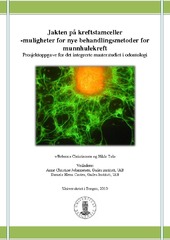| dc.contributor.author | Tolo, Hilde | en_US |
| dc.contributor.author | Christiansen, Rebecca | en_US |
| dc.date.accessioned | 2011-01-07T10:24:51Z | |
| dc.date.available | 2011-01-07T10:24:51Z | |
| dc.date.issued | 2010-01-28 | eng |
| dc.date.submitted | 2010-01-28 | eng |
| dc.identifier.uri | https://hdl.handle.net/1956/4419 | |
| dc.description.abstract | The five year survival rate of patients diagnosed with oral cancer is no more than 60-70%. The survival rate is dramatically decreased to 30-40% if there are metastases in the regional lymph nodes. Current cancer therapy is based on the idea that all cancer cells are alike, and that they respond in a similar way to treatment. However, recent studies have shown that within the same tumour the cancer cells respond differently to treatment, and that there exists a sub-population of cancer cells being more resistant to radiation and chemotherapy than the bulk of the tumour cells. This sub-population of cancer cells has also been proven to share several properties with the somatic stem cells, and has therefore been called the 'cancer stem cell sub-population'. Stem cells are defined by their capacity to undergo self-renewal as well as to give rise to specialized cells by differentiation. By extrapolation, the term 'cancer stem cells' defines the cancer cells within a tumour that posses the capacity to self-renew and to cause the heterogeneous lineages of cancer cells that comprise the tumour. Experimentally, cancer stem cells are defined as cancer cells that are able to generate new tumours in immunodefficient animals with similar histological appearance as the tumour from which they were isolated. Thus "tumour-initiating cell" and "tumourigenic cell" are also used as alternative terms in the literature to describe putative cancer stem cells. The cancer stem cells are assumed to play an important role in the development, growth and metastasis of cancer. The fact that cancer stem cells are able to resist cancer therapy makes them an attractive potential target for developing new and improved cancer therapies. In order to develop therapies that target the cancer stem cell population, it is of crucial importance to have good knowledge on their properties and biological behaviour. Advanced research must be done to define the unique characteristics of the cancer stem cells compared to the bulk of the cancer cells on one hand and to the normal somatic stem cells on the other hand. Identification of successful ways for targeting the cancer stem cell sub-population may lead to more effective treatment strategies and consequently to improved therapeutic outcome for cancer patients. | en_US |
| dc.description.abstract | Munnhulekreft er en kreftform som har en overlevelse på 60-70 % etter fem år, og den blir redusert til kun 30-40 % etter fem år dersom man har spredning til lymfesystemet. Å overleve munnhulekreft er ofte assosiert med flere senplager som bidrar til redusert livskvalitet for den som blir rammet. Kreftbehandlingen man benytter i dag tar utgangspunkt i at alle kreftceller er like. Nyere forskning har vist at en andel av kreftcellene i en tumor er mer motstandsdyktige mot stråling og cellegift enn resten av kreftcellene. Disse cellene blir av noen kalt for kreftstamceller, og de er definert som kreftceller med stamcellelignende egenskaper. Stamceller er celler som har evnen til å fornye seg selv uendelig, og de kan differensieres til spesialiserte celler. Når man isolerer kreftceller med stamcellelignende egenskaper og transplanterer dem til mus, kan de gjenskape tumoren som de ble hentet ut fra. Kunnskapen om kreftstamcellene fører sannsynligvis med seg nye muligheter for utvikling av mer effektiv behandling av kreft. Det er en lang vei å gå fra å lokalisere kreftstamcellene til å utvikle nye og mer effektive behandlingsmetoder. For å lykkes i utviklingen nye behandlingsmetoder med utgangspunkt i denne kunnskapen, krever det at man lærer kreftstamcellene bedre å kjenne. Man må finne ut hva som skiller kreftstamcellene fra resten av kreftcellene, og man må vite mer om hva som skiller kreftstamcellene fra somatiske stamceller. I dag er immunhistokjemi, fluorescensaktivert cellesortering og forskning på mus de viktigste forskningsmetodene som blir brukt i jakten på kreftstamceller. Det blir spennende å se hvilke konsekvenser den nye kunnskapen om kreftstamcellene får for fremtidens kreftbehandling, og ikke minst følgene det får for fremtidens kreftpasienter. | en_US |
| dc.format.extent | 706754 bytes | eng |
| dc.format.mimetype | application/pdf | eng |
| dc.language.iso | nob | eng |
| dc.publisher | The University of Bergen | eng |
| dc.subject | Munnhulekreft | nob |
| dc.title | Jakten på kreftstamceller - muligheter for nye behandlingsmetoder for munnhulekreft | nob |
| dc.type | Master thesis | |
| dc.rights.holder | Copyright the author. All rights reserved | |
| dc.rights.holder | The author | |
| dc.description.localcode | OD3PROSJ/05 | |
| dc.description.localcode | MAOD-ODONT | |
| dc.subject.nus | 764106 | eng |
| dc.subject.nsi | VDP::Medisinske Fag: 700::Klinisk medisinske fag: 750::Onkologi: 762 | nob |
| dc.subject.nsi | VDP::Medisinske Fag: 700::Klinisk odontologiske fag: 830::Oral medisin: 835 | nob |
| fs.subjectcode | OD3PROSJ/05 | |
